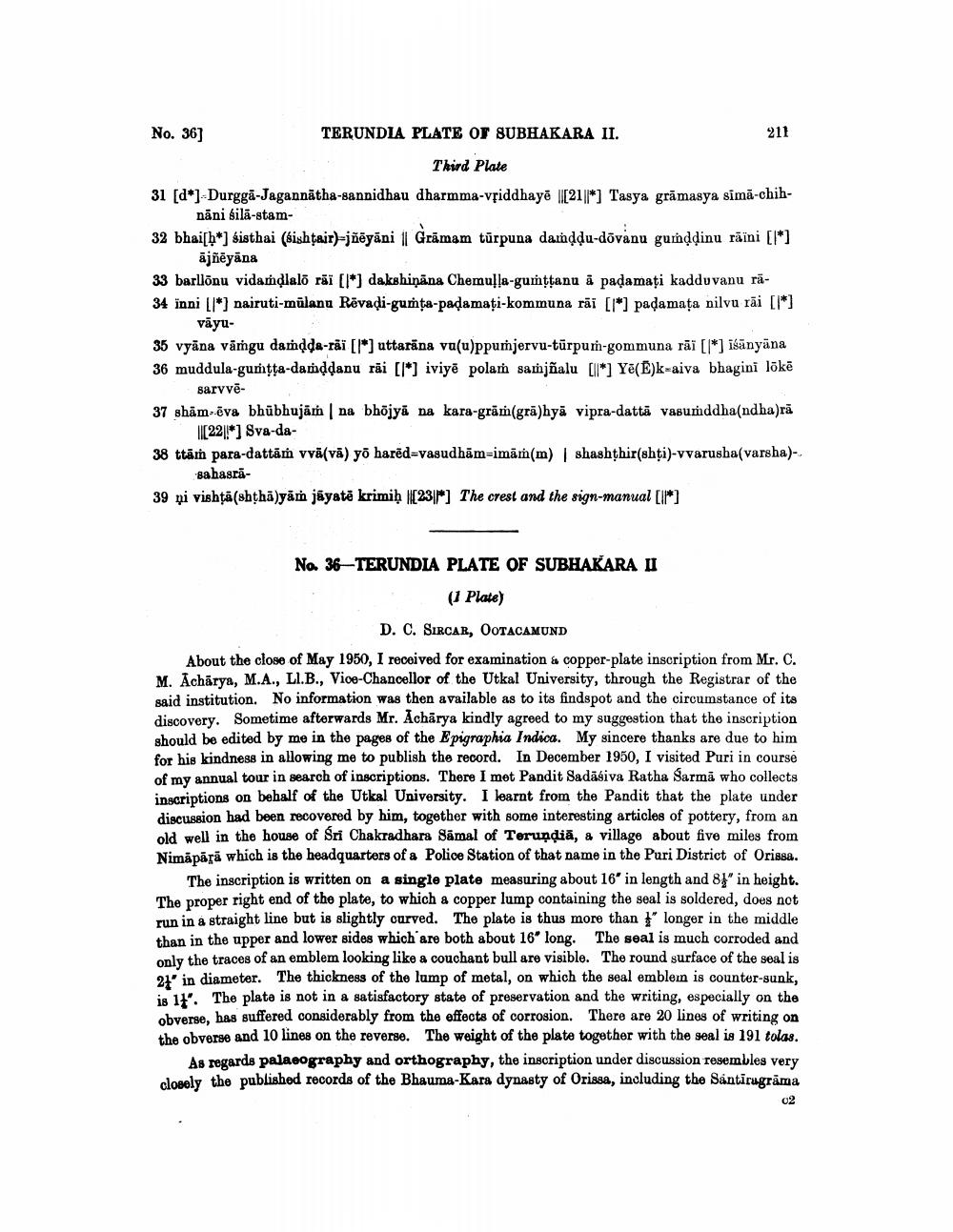________________
No. 36] TERUNDIA PLATE OF SUBHAKARA II.
211 Tkid Plate 31 [d*]-Durggā-Jagannātha-sannidhau dharmma-vsiddhayē ||[21||*] Tasya grāmasya simā-chih
nāni bilā-stam32 bhai[b*] sisthai (sishtair)-jñēyāni || Grāmam tūrpuna damddu-dovanu gumddinu rāžni [l*]
ājñēyāna 33 barllõnu vidamdlalo rāï [l*) dakshiņāna Chemulla-gumţtanu å padamați kadduvanu rā34 inni [l*) nairuti-mūlanu Rēvaţi-gumte-padamati-kommuna rāi [1*padamata nilvu rāi []*]
vāyu
35 vyāna vārgu damdda-râï [l*) uttarāna va(u)ppumjervu-tūrpum-gommuna rāï [l*] išānyāna 36 muddula-gunțţa-damddanu rāi [l*) iviyē polam samjñalu [ll*] Yē(E)k=aiva bhagini lokē
sarvvē37 shām-ēva bhūbhujām na bhõjyā na kara-grām(grā)hyā vipra-dattā vasuddha(ndha)rā
||[22.* ] Sva-da38 ttām para-dattām vvā(vā) yo harēd=vasudhām=imām(m) shashthir(shți)-vvarusha(varsha)
sahasra39 pi vishtā(shthā)yām jāyatē krimiḥ |[23]p] The crest and the sign-manual [IM*]
No 36-TERUNDIA PLATE OF SUBHAKARA II
(1 Plate)
D. C. SIRCAR, OOTACAMUND About the close of May 1950, I received for examination & copper-plate inscription from Mr. C. M. Achārya, M.A., Ll.B., Vice-Chancellor of the Utkal University, through the Registrar of the said institution. No information was then available as to its findspot and the circumstance of its discovery. Sometime afterwards Mr. Achārya kindly agreed to my suggestion that the inscription should be edited by me in the pages of the Epigraphia Indica. My sincere thanks are due to him for his kindness in allowing me to publish the record. In December 1950, I visited Puri in course of my annual tour in search of inscriptions. There I met Pandit Sadasiva Ratha Sarmā who collects inscriptions on behalf of the Utkal University. I learnt from the Pandit that the plate under discussion had been recovered by him, together with some interesting articles of pottery, from an old well in the house of Sri Chakradhara Sámal of Terundia, & village about five miles from Nimāpārā which is the headquarters of a Police Station of that name in the Puri District of Orissa.
The inscription is written on a single plate measuring about 16' in length and 8}" in height. The proper right end of the plate, to which a copper lump containing the seal is soldered, does not run in a straight line but is slightly curved. The plate is thus more than longer in the middle than in the upper and lower sides which are both about 16' long. The seal is much corroded and only the traces of an emblem looking like a couchant bull are visible. The round surface of the seal is 21 in diameter. The thickness of the lump of metal, on which the seal emblern is counter-sunk, is 17'. The plate is not in a satisfactory state of preservation and the writing, especially on the obverse, has suffered considerably from the effects of corrosion. There are 20 lines of writing on the obverse and 10 lines on the reverse. The weight of the plate together with the seal is 191 tolas.
As regards palaeography and orthography, the inscription under discussion resembles very closely the published records of the Bhauma-Kara dynasty of Orissa, including the Santirugrāma
02




